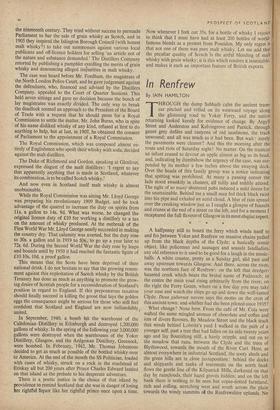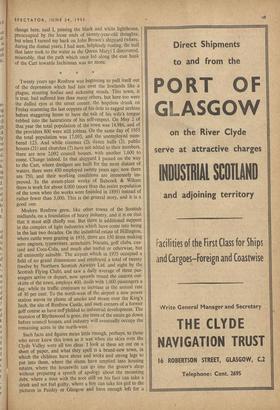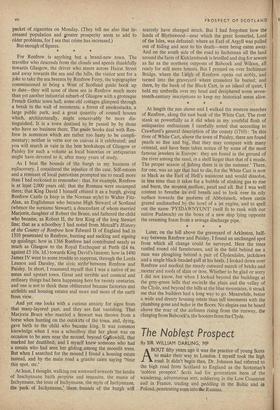In Renfrew
By IAIN HAMILTON T, HROUGH the damp Sabbath calm the ancient tram- car pitched and rolled on its westward voyage along the glistening road to Yoker Ferry, and the native returning looked keenly for evidence of change. By Argyll Street and Anderston and Kelvingrove and Partick, through gaunt grey defiles and canyons of red sandstone, the track unwound; and all was much as it had been. But wait : surely the pavements were cleaner? And this the morning after the routs and riots of Saturday night! No matter. On the tramcar an infant ceased to devour an apple almost as big as its head, and, indicating by dumbshow the urgency of the case, was sus- pended by its mother a few inches above the swaying deck. Over the heads of this family group was a notice indicating that spitting was prohibited. At many a passing corner the lads stood swankily in clusters, all tidily and teddily attired. The sight of so many shuttered pubs induced a mild desire for the unattainable. Behind me a small man fed thick black twist into his pipe and exhaled an acrid cloud. A blur of rain spread over the creaking window just as I caught a glimpse of funnels and cranes at the end of a street on the left, and for a moment I recaptured the full flavour of Glasgow in its most elegiac aspect.
* * * A halfpenny still to board the ferry which winds itself to and fro between Yoker and Renfrew on massive chains pulled up from the black depths of the Clyde; a basically comic object, like policemen and sausages and seaside landladies, any old reference to it used to be good for a laugh in the music- halls. A white coaster, pretty as a Sunday ,girl, slid past and away upstream towards Glasgow. And there, across the river, was the northern face of Renfrew : on the left that dredger- haunted creek which bears the brutal name of Pudzeoch; in the centre the main road rising arbitrarily from the river; on the right the Ferry Green, where on 'a tine day you may take your ease and watch the ships go up and down the well-tamed Clyde. Deus gubernat navem says the motto on the crest of this ancient town; and whither had she been piloted since 1935?
What change? None here. From the café of Mr. Coia were wafted the same mingled aromas of chocolate and coffee and ices of divers flavours. By Meadow Street and the black track that winds behind Lobnitz's yard I walked in the path of a younger self, past a tree that had fallen on its side twenty years ago and lay flourishing still, a hardy cripple, and out on to the meadow that runs, between the Clyde and the trees of Blythswood, towards the mouth of the River Cart. Here, as almost everywhere in industrial Scotland, the sooty sheds and the green hills are in close juxtaposition : behind the docks and shipyards and ranks of tenements on the north bank flows the gentle line of the Kilpatrick Hills, darkened on that day by rainclouds, their hazel groves hidden; and on the left bank there is nothing to be seen but copse-dotted farmland, rich and rolling, stretching west and south across the plain towards the windy summits of the Renfrewshire uplands. No change here, said I, passing the black and white lighthouse, preoccupied by the loose ends of twenty-year-old thoughts; but when I turned my back on John Brown's shipyard (where, during the dismal years, 1 had seen, helplessly rusting, the hull that later took to the water as the Queen Mary) I discovered, miserably, that the path which once led along the cast bank of the Cart towards Inchinnan was no more.
Twenty years ago Renfrew was beginning to pull itself out of the depression which had lain over the lowlands like a plague, stunting bodies and sickening minds. This town, it is true. had suffered less than many others, but here too were the dulled eyes at the street corner, the hopeless drunk on Friday scattering the last coppers of his dole to ragged urchins before staggering home to have the salt of his wife's tongue rubbed into the lacerations of his self-respect. On May 2 of that year the total population of the town was 14,986, and of the providers 800 were still jobless. On the same day of 1955 the total population was 17,093, and the unemployed num- bered 123. And while cinemas (2), dance halls (2), public houses (21) and churches (7) have not added to their numbers, there are now 2,092 council houses, with another 1,600 to come. Change indeed. In that shipyard I passed on the way to the Cart, where dredgers are built for the most distant of waters, there were 450 employed twenty years ago; now there are 750, and their working conditions are immensely im- proved. In the steam-plant works of Babcock & Wilcox there is work for about 8,000 (more than the entire population of the town when the works were founded in 1895) instead of rather fewer than 5,000. This is the general story, and it is a good one.
Modern Renfrew grew, like other towns of the Scottish midlands, on a foundation of heavy industry, and it is on that that it must still chiefly rest. But there is additional support in the complex of light industries which have come into being in the last two decades. On the industrial estate of Hillington, where cattle were grazing in 1935, there are 150 firms making aero engines, typewriters, armchairs. biscuits, golf clubs, cus- tard and Coca-Cola, and much else useful or otherwise, but all eminently saleable. The airport which in 1935 occupied a field of no grand dimensions and employed a total of twenty (twelve by Northern Scottish Airways Ltd. and eight by the Scottish Flying Club). and saw a daily average of three pas- sengers arrive or depart, now sprawls round the eastern out- skirts of the town, employs 400. deals with 1,000 passengers a day, while its traffic continues to increase at the annual rate of 30 per cent. To the north-west of the airport a new power station waves its plume of smoke and steam over the King's Inch. the site of Renfrew Castle, and such corners of a former golf course as have nor yielded to industrial development. The mansion of Blythswood is gone, the trees of the estate go down before council houses. and industry will eventually occupy the remaining acres in the north-west. packet of cigarettes on Monday. (They tell me also that in- creased population and greater prosperity seem to add to older problems, for I see that crime has increased.) - But enough of figures.
For Renfrew is anything but a brand-new town. The traveller who descends from the clouds and speeds thankfully towards Glasgow, the driver who steers across Hairst Street and away towards the sea and the hills, the visitor sent for a joke to take the sea breezes by Renfrew Ferry, the topographer commissioned to bring a West of Scotland guide book up to date—they will none of them see in Renfrew much more than yet another industrial suburb of Glasgow with a grotesque French Gothic town hall, some old cottages glimpsed through a break in the wall of tenements, a forest of smokestacks, a large public park, and a great quantity of council houses which, architecturally, might conceivably be more dis- tinguished. It is a town destined to be passed by by those who have no business there. The guide books deal with Ren- frew in sentences which are rather too hasty to be compli- mentary; neither in verse nor on canvas is it celebrated; and you will search in vain in the best bookshops of Glasgow or Paisley for such a volume as local historian or antiquarian might have devoted to it, after many years of study.
As I beat the bounds of the burgh in my business of rediscovery, I considered the injustice of the case. Self-esteem and a remnant of local patriotism prompted me to recall more than I had reckoned to remember : that, for example. Renfrew is at least 2,000 years old; that the Romans were encamped there; that King David I himself created it as a burgh, giving Renfrew Castle (a keep in the Norman style) to Walter Fitz- Alan, an Englishman who became High Steward of Scotland (whence the surname Stewart), a descendant of whom married Marjorie, daughter of Robert the Bruce, and fathered the child who became, as Robert II, the first King of the long Stewart line; that as a schoolboy I had noted from Metcalf's History of the County of Renfrew how Edward II of England had in 1310 penetrated to Renfrew, burning and sacking and signing up quislings; how in 1366 Renfrew had contributed nearly as much as Glasgow to the Royal Exchequer at Perth (£4 6s. against £5 10s. Id.) towards King David's ransom; how in 1490 James IV went to some trouble to suppress, through the Lords Lennox and Darnley, the civic strife between Renfrew and Paisley. In short, I reassured myself that I was a native of no mean and upstart town. Great and terrible and comical and ordinary things had been happening here for twenty centuries. and one is not to think them obliterated because factories and airfields and housing estates seal more and more of the earth from view.
And yet one looks with a curious anxiety for signs from that many-layered past; and they are fast vanishing. That Marjorie Bruce who married a Stewart was thrown from a • horse when hunting on the outskirts of the town, and, dying, gave birth to the child who became king., It was common knowledge when I was a schoolboy that her ghost was on occasion to be seen near the mound, beyond Gelowhill, that marked her deathbed; and I myself knew someone who had a cousin who had seen her gliding among the moonlit trees. But when I searched for the mound I found a housing estate instead, and by the main road a granite cairn saying 'Near this spot, etc.'
At least, I thought, walking out westward towards 'the Landis of lnschynnane baith propirte and tenandre, the manis of Inchynnane, the toun of Inchynnane, the myln of Inchynnane, the park of Inchynnane,' these bounds of the burgh will scarcely have changed much. But I had forgotten how the lands of Blythswood—near which the great Somerled, Lord of the Isles, was defeated; where an Earl of Argyll was pulled out of hiding and sent to his death—were being eaten away. And on the south side of the road to Inchinnan all the land around the farm of Kirkland neuk is levelled and dug for sewers as far as the northern outposts of Babcock and Wilcox, all ready for still more houses. But I pressed on over Inchinnan Bridge, where the Ltigh of Renfrew opens out nobly, and turned into the graveyard where crusaders lie buried; and there, by the bank of the Black Cart, in an island of quiet, I held my umbrella over my head and deciphered some seven- teenth-century inscriptions to keep my historical sense alive.
At length the sun shone and I walked the western marches of Renfrew, along the east bank of the White Cart. The river stank as powerfully as it did when in my youthful flush of antiquarian enthusiasm I carefully noted that according to Crawfurd's general description of the county (1710): 'In this river of White Cart, above the town of Paisley, there are found pearls so fine and big, that they may compare with many oriental, and have been taken notice of by some of the most famous jewelers in Europe: they are found in the ground of the river among the sand, in a shell larger than that of a music. The proper season of fishing them is in the summer.' There, for one, was an age that had to die, for the White Cart is now as black as the t arl of Hell's waistcoat and would dissolve, in less time than it takes for a bubble of stinking gas to rise and burst, the stoutest mollusc, pearl and all. But I was well content to breathe its evil breath and to look over its oily surface towards the pastures of Abbotsinch, where cattle grazed undisturbed by the howl of a jet engine, and to spell out the name `PYIDAWNYUNT' (well fit to rank with our native Pudzeoch) on the bows of a new ship lying opposite the creaming foam from a sewage discharge pipe.
Later, on the hill above the graveyard of Arkleston, half- way between Renfrew and Paisley, I found an unchanged spot from which all change could be surveyed. Here the trees rustled round old farmhouses, and in the field behind me a man was ploughing behind a pair of Clydesdales, jackdaws and a single black-headed gull at his heels. I looked down over Renfrew and marked.the steady outward march of bricks and _mortar and roofs of slate or iron. Whether to be glad or sorry I did not know, but when I looked beyond the buildings at the grey-green hills that encircle the plain and the valley of the Clyde, and beyond the hills at the blue mountains, it struck me that the builders had a long way to go. Meanwhile, better a wide and dreary housing estate than tall tenements with the plumbing gone and holes in the floors. No elegies can be heard above the roar of the airliners rising from the runway, the clanging from Babcock's, the hooters from the Clyde.



















































 Previous page
Previous page